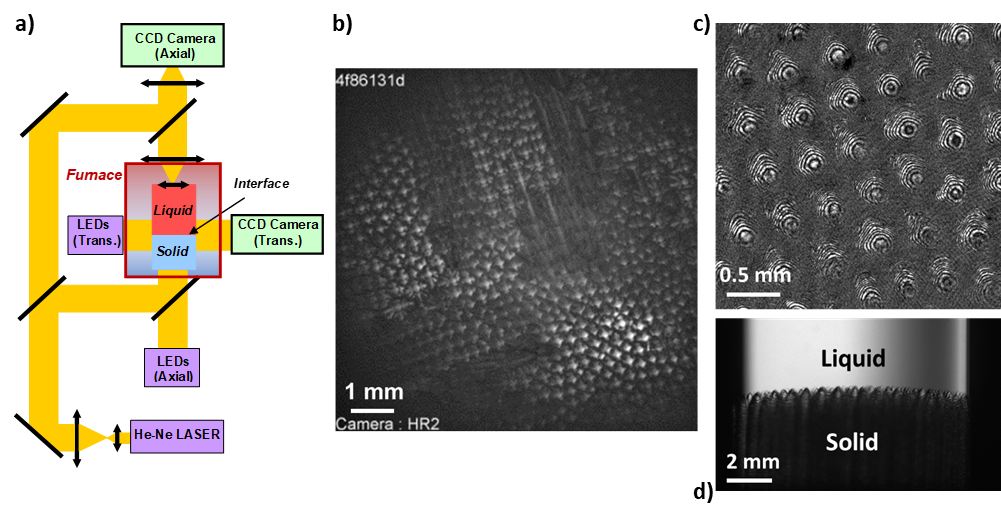Dynamics of microstructure formation during solidification: the use of transparent analogs of metallic systems for in situ studies
Laboratories : IM2NP, CNRS, Aix-Marseille Univ.

Metallic alloys are used in a wide range of applications, including civil engineering and the transport industry. The main properties of metallic products, particularly the mechanical ones, are governed by the characteristics of the microstructure developed during the solidification stage since its formation is accompanied by a redistribution of the alloy’s constituent elements. Therefore, from a practical viewpoint, the ability to predict accurately the detailed time evolution of microstructure under prescribed growth conditions is critical for optimizing both material properties and processing routes. A major impediment to the study of these solidification microstructures is fluid flow in the molten alloy, which makes it nearly impossible on Earth to obtain benchmark data in bulk samples. Such data is fundamental to validate the predictions of theoretical and computational models. The low gravity conditions of space where fluid flow is suppressed, allow to study the interfacial pattern formation without inhomogeneities of alloy composition under well controlled growth conditions, and consequently to establish a benchmark database
The microstructure of the final material is the result of a dynamic process, and therefore depends on the entire history of its formation. Real-time in situ monitoring of the microstructure formation is a major advantage offered by the use of transparent organic alloys, analogous to metallic alloys in terms of solidification, but whose transparency to visible light means that conventional optical methods can be used to observe the interface.
The DECLIC-DSI (DEvice for the study of Critical LIquids and Crystallization – Directional Solidification Insert) was developed in the frame of a joint CNES-NASA project. It is dedicated to the in situ and real-time characterization of the dynamics of solid-liquid interface morphology formation in transparent organic bulk samples. DECLIC has been installed on board the International Space Station (ISS) since 2009. Studies in the DECLIC-DSI device are being developed as part of a scientific collaboration between our team and researchers at Northeastern University (Boston, USA) and Iowa State University (Ames, USA). Essentially, the DECLIC-DSI consists of a Bridgman furnace where the experimental cartridge containing the alloy is inserted. Different optical diagnostics are available to characterize the pattern (top-view observation), the interface motion and shape (side observation) or the cell/dendrite shape (interferometry) [1].
Over the last decade, the experiments carried out in the DECLIC-DSI have enabled to gain fundamental insights into mechanisms of cellular and dendritic microstructure formation, through the observations made and their quantitative computational modeling [2-10]. Two experimental campaigns were conducted on samples of different compositions, each lasting more than a year. Over a hundred solidification experiments were carried out in microgravity, supplemented by a selection of equivalent experiments on the ground to analyse convective effects [11]. A third space campaign is currently in preparation.
In situ observation during microgravity directional solidification of a succinonitrile-0.46wt% camphor alloy with a velocity jump at half-way from 1.5 to 12 μm/s, within a temperature gradient G = 12 K/cm. These optical images were recorded from a camera with an immersed lens in the liquid directly facing the solidification front (top-view images).
Related references :
[1] F.L. Mota, M. Medjkoune, L.S. Littles, A. Karma, N. Bergeon, Solidification furnace for in situ observation of bulk transparent systems and image analysis methods, Review of Scientific Instruments 94(6) (2023).
[2] Y. Song, F.L. Mota, D. Tourret, K. Ji, B. Billia, R. Trivedi, N. Bergeon, A. Karma, Cell invasion during competitive growth of polycrystalline solidification patterns, Nature Communications 14(1) (2023) 2244.
[3] F.L. Mota, K. Ji, L.S. Littles, R. Trivedi, A. Karma, N. Bergeon, Influence of macroscopic interface curvature on dendritic patterns during directional solidification of bulk samples: Experimental and phase-field studies, Acta Mater. 250 (2023).
[4] F.L. Mota, J. Pereda, K. Ji, Y. Song, R. Trivedi, A. Karma, N. Bergeon, Effect of sub-boundaries on primary spacing dynamics during 3D directional solidification conducted on DECLIC-DSI, Acta Mater. 204 (2021).
[5] F.L. Mota, N. Bergeon, A. Karma, R. Trivedi, J.M. Debierre, Oscillatory-nonoscillatory transitions for inclined cellular patterns in three-dimensional directional solidification, Phys. Rev. E 102(3) (2020) 032803.
[6] J. Pereda, F.L. Mota, J.M. Debierre, B. Billia, R. Trivedi, A. Karma, N. Bergeon, Experimental characterization and theoretical analysis of cell tip oscillations in directional solidification, Phys. Rev. E 102(3) (2020) 032804.
[7] Y. Song, D. Tourret, F.L. Mota, J. Pereda, B. Billia, N. Bergeon, R. Trivedi, A. Karma, Thermal-field effects on interface dynamics and microstructure selection during alloy directional solidification, Acta Mater. 150 (2018) 139-152.
[8] J. Pereda, F.L. Mota, L. Chen, B. Billia, D. Tourret, Y. Song, J.-M. Debierre, R. Guerin, A. Karma, R. Trivedi, N. Bergeon, Experimental observation of oscillatory cellular patterns in three-dimensional directional solidification, Phys. Rev. E 95(1) (2017) 012803.
[9] F.L. Mota, N. Bergeon, D. Tourret, A. Karm, R. Trivedi, B. Billia, Initial transient behavior in directional solidification of a bulk transparent model alloy in a cylinder, Acta Mater. 85 (2015) 362-377.
[10] N. Bergeon, D. Tourret, L. Chen, J.-M. Debierre, R. Guerin, A. Ramirez, B. Billia, A. Karma, R. Trivedi, Spatiotemporal Dynamics of Oscillatory Cellular Patterns in Three-Dimensional Directional Solidification, Phys. Rev. Lett. 110(22) (2013).
[11] F.L. Mota, Y. Song, J. Pereda, B. Billia, D. Tourret, J.-M. Debierre, R. Trivedi, A. Karma, N. Bergeon, Convection Effects During Bulk Transparent Alloy Solidification in DECLIC-DSI and Phase-Field Simulations in Diffusive Conditions, Jom 69(8) (2017) 1280-1288.
